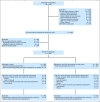Yoga's impact on inflammation, mood, and fatigue in breast cancer survivors: a randomized controlled trial
- PMID: 24470004
- PMCID: PMC3965259
- DOI: 10.1200/JCO.2013.51.8860
Yoga's impact on inflammation, mood, and fatigue in breast cancer survivors: a randomized controlled trial
Abstract
Purpose: To evaluate yoga's impact on inflammation, mood, and fatigue.
Patients and methods: A randomized controlled 3-month trial was conducted with two post-treatment assessments of 200 breast cancer survivors assigned to either 12 weeks of 90-minute twice per week hatha yoga classes or a wait-list control. The main outcome measures were lipopolysaccharide-stimulated production of proinflammatory cytokines interleukin-6 (IL-6), tumor necrosis factor alpha (TNF-α), and interleukin-1β (IL-1β), and scores on the Multidimensional Fatigue Symptom Inventory-Short Form (MFSI-SF), the vitality scale from the Medical Outcomes Study 36-item Short Form (SF-36), and the Center for Epidemiological Studies-Depression (CES-D) scale.
Results: Immediately post-treatment, fatigue was not lower (P > .05) but vitality was higher (P = .01) in the yoga group compared with the control group. At 3 months post-treatment, fatigue was lower in the yoga group (P = .002), vitality was higher (P = .01), and IL-6 (P = .027), TNF-α (P = .027), and IL-1β (P = .037) were lower for yoga participants compared with the control group. Groups did not differ on depression at either time (P > .2). Planned secondary analyses showed that the frequency of yoga practice had stronger associations with fatigue at both post-treatment visits (P = .019; P < .001), as well as vitality (P = .016; P = .0045), but not depression (P > .05) than simple group assignment; more frequent practice produced larger changes. At 3 months post-treatment, increasing yoga practice also led to a decrease in IL-6 (P = .01) and IL-1β (P = .03) production but not in TNF-α production (P > .05).
Conclusion: Chronic inflammation may fuel declines in physical function leading to frailty and disability. If yoga dampens or limits both fatigue and inflammation, then regular practice could have substantial health benefits.
Trial registration: ClinicalTrials.gov NCT00486525.
Conflict of interest statement
Authors' disclosures of potential conflicts of interest and author contributions are found at the end of this article.
Figures



References
-
- Hewitt M, Rowland JH, Yancik R. Cancer survivors in the United States: Age, health, and disability. J Gerontol A Biol Sci Med Sci. 2003;58:82–91. - PubMed
-
- Mock V. Evidence-based treatment for cancer-related fatigue. J Natl Cancer Inst Monogr. 2004;32:112–118. - PubMed
-
- Jones LW, Eves ND, Haykowsky M, et al. Exercise intolerance in cancer and the role of exercise therapy to reverse dysfunction. Lancet Oncol. 2009;10:598–605. - PubMed
-
- Holmes MD, Chen WY, Feskanich D, et al. Physical activity and survival after breast cancer diagnosis. JAMA. 2005;293:2479–2486. - PubMed
-
- Payette H, Roubenoff R, Jacques PF, et al. Insulin-like growth factor-1 and interleukin 6 predict sarcopenia in very old community-living men and women: The Framingham Heart Study. J Am Geriatr Soc. 2003;51:1237–1243. - PubMed
Publication types
MeSH terms
Substances
Associated data
Grants and funding
LinkOut - more resources
Full Text Sources
Other Literature Sources
Medical

